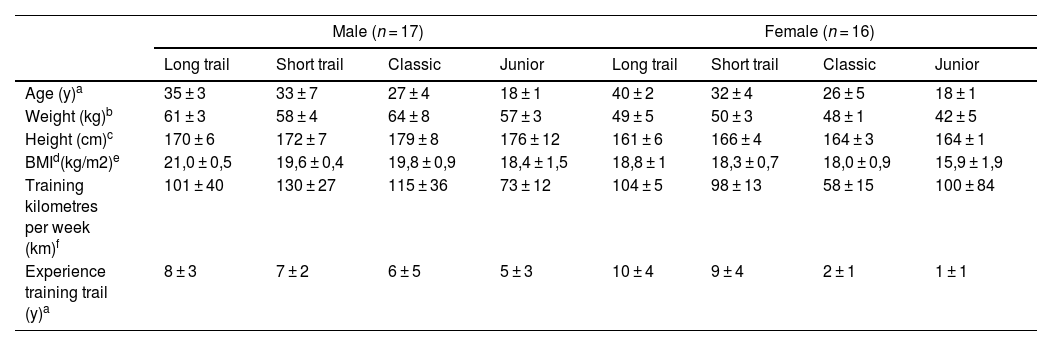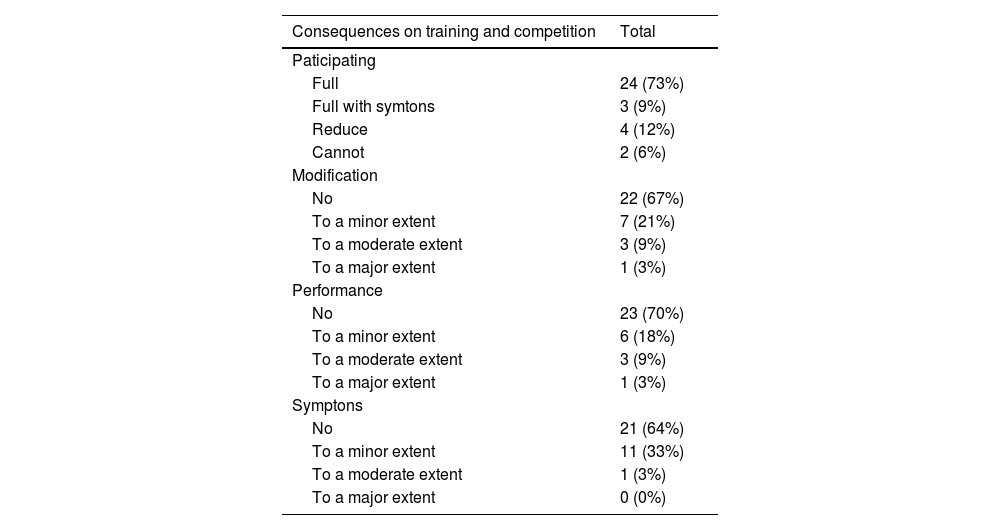The recent professionalization of trail running has focussed the interest in this sport. The aim is to describe the epidemiology of musculoskeletal injuries and illnesses among professional Spanish trail runners team during the month of training prior to the World Mountain and Trail Running Championship 2022.
Material and Methods33 professional athletes from Spanish National Team that competed in the World Championship participated in the study. They completed a pre-participation health questionnaire based on the specific questionnaire "Oslo Sport Trauma Research Center - Health 2″.
Results55% of the athletes suffered a musculoeskeletal injury or health problem during the last month. 12% had to modify their performance in a moderate or severe way. By anatomic location the foot was the most affected with 33% of the cases, followed by the ankle in 25%. Among the diagnoses, chronic overuse musculoskeletal injuries represented 80% with tendinopathy being the most frequent. Regarding the symptons 53% affected upper respiratory tract and 23% gastrointestinal problems.
ConclusionsThere is a high risk for the professional trail runners who carry out a continued practice of trail running to suffer an injury or health problem, although most of such injuries or health problems have little impact on their sports performance. The foot and the upper respiratory system are the most affected.
Trail running is a sports discipline that involves on-foot races with a distance ranging from 1 km to more than 80 km and which comprises a unique combination of variations in elevation, discontinuous running surfaces, global location and a varied environment that ranges from desert to mountain forests.1
The International Trail Running Association (ITRA) defines trail running as a race on foot with a clearly marked route (usually in natural environments and terrains such as mountains, deserts, forests or plains) with a maximum of 20% of the total route on paved road.2 Participants are semi to fully self-sufficient and are sometimes required to use running packs in races to carry limited nutritional supplies and safety equipment (e.g. clothing or communication).3
During the past decade the popularity of trail running has grown at a 15% annual rate and the future looks even brighter as new countries and entrants discover the joy of running in the nature, with the current estimates at 20 million trail-runners worldwide.4
In the same way, trail running has recently undergone progressive professionalization as a result of the promotion of national and international federations and the support of important sports sponsors. In 2015, trail running was recognised by the World Athletics (WA) as a discipline of athletics4 and in November 2022 ITRA and WA organised the first World Mountain and Trail Running Championship in Thailand with more than 30 national teams and with the following race categories: long trail, short trail, classic uphill, classic up and down and junior classic up and down. All of such categories were both for men and for women.5
The irregular running terrain with stones, roots and mud, the long distances (more than 50 km in some races), the large elevation gains/losses, and the adverse environmental conditions increase the risk of injuries and make them unique compared to regular outdoor or track running.1,6 Trail running has a high incidence of up to 61.2 injuries per 1000 h reported.7
Furthermore, due to its recent popularity8, the number of publications in the scientific bibliography about injuries and illnesses in mountain runners is low9, especially if we refer to professional runners, as we have not found publications in this regard.
The primary aim of this paper is to describe the epidemiology of injury and illnesses among professional trail runners during the month of training prior to the first Mountain and Trail Running World Championship.
Material and methods33 professional athletes participated in this study. All of them members of the Spanish National Team participating in the first Mountain and Trail Running World Championship held in Thailand in November 2022.5
Sports injuries and illnesses suffered by the above athletes in the month prior to the championship were studied retrospectively using a pre-participation health questionnaire (PHQ)10 based on the specific questionnaire "Oslo Sport Trauma Research Center - Health 2″ in its internationally validated translation into Spanish by Bailón-Cerezo et al.11 In addition, data about the personal and training characteristics of the participants (i.e. age, sex, height, weight, body mass index, sport modality, average weekly kilometres in the last month and years of specific trail running training) were collected.
All the questionnaires were completed on an anonymously and voluntarily basis. All the information was recorded in accordance with The Code of Ethics of the World Medical Association (Declaration of Helsinki).
The PHQ was available in a paper format and distributed by the medical team three days before the competition. Athletes were asked to complete the questionnaire themselves or with the help of the team physician, if needed.
Statistical analysis was performed with the IBM SPSS Statisticsࣨ (versión 19).
ResultsThe 33 athletes that made up the Spanish national team, of whom 17 were men and 16 were women, answered the questionnaire. No one refuse to participate in the study. Their demographic and sport characteristics are shown in Table 1.
Demographic and sport characteristics of the athletes.
a: years, b: kilograms, c: centimetres, d: body mass index, e: kilograms divide height in metres square f: kilometres.
55% of the athletes stated to have suffered an injury or health problem in the last month while 45% denied any previous problem.
As for the difficulty in participating in training and competitions (Table 2), 73% stated that they did so normally, 9% did so although with mild symptoms, 12% reduced their participation and 6% were not able to participate.
Consequences on training and competition performance due to a musculoeskeletal injury or illness.
67% did not modified their training or competition, 21% slightly modified it, 9% moderately and 3% severely.
Considering the modification of performance due to injury or illness, 70% did not altered their performance, 18% altered it slightly, 9% moderately and 3% severely.
Regarding the symptoms experienced during the month prior to the competition, 64% stated that they did not suffer any symptoms or health problems, 33% mild symptoms and only 3% moderate symptoms. Among all those who presented symptoms, 53% affected upper respiratory tract (i.e. sore throat, nasal congestion and respiratory distress), 23% gastrointestinal problems (i.e. diarrhea, nausea and abdominal pain) and 15% fatigue or general discomfort.
By anatomical location (Graphic 1), the most affected anatomical area was the foot in 33% of the cases, followed by the ankle in 25%, the pelvic area in 17% and the lower leg, knee and thigh with 8%, respectively. Among the diagnoses, chronic overuse injuries represented 80%, with tendinopathy being the most frequent (i.e. hamstrings, posterior tibial tendon and plantar fascia), followed by bone edema (i.e. calcaneus and sacrum). Among acute injuries, ankle sprain and contusion were the most frequent.
DiscussionThe current scientific evidence related to injuries and illnesses in mountain runners comes mainly from cross-sectional studies obtained in single-day competitions which are focused on injuries and illnesses during competition and whose population is mainly male runners of middle age and amateur level.6
Only four studies included training-related injury outcomes12-15 but they focused on amateur runners and majority male runners.
Our study, to date, is the first study focused on professional runners, that is, athletes who are (i) fully dedicated to training and competing in this sport within a federative structure and (ii) compete in national and international events. It collects retrospectively, through an internationally validated questionnaire, the injuries and health problems suffered by the participating athletes during the month prior to the World Championship, as well as their impact on the athletes training, competitions and physical performance. In addition, the athletes subject to this study are balanced in terms of sex (i.e. 51% men and 49% women).
The main results of the study are that (i) 55% of the athletes had an injury or health problem during the month prior to their participation in the World Championship and (ii) 12% had to modify their training or their participation in the competition in a moderate or severe form. Our interpretation of these data is that there is a high risk for the athletes who carry out a continued practice of trail running to suffer an injury or health problem, although most of such injuries or health problems have little impact on their sports performance. Notwithstanding the above, approximately one to ten athletes had to modify their sports performance and needed proper treatment and medical follow-up.
Regarding the 12% of the athletes who had to moderately or severely modify their preparation in the championship, three cases were due to an acute injury related to training (i.e. a muscle tear of the medial calf, lateral ankle sprain and knee contusion from fall) and one due to overuse (sacral bone edema).
As regards the anatomical location and in line with majority published series6,16, the lower extremity was the most affected, with the foot first, followed by the ankle and pelvis.
Regarding diseases, in our series the respiratory system was the most affected with symptoms such as nasal congestion and sore throat, followed by the digestive system. This data contrasts with the majority of the published series that also indicate the digestive system to be the most affected system.6 We believe that such circumstance is due to the fact that most of the papers are focused on competitions where athletes make strenuous efforts with high degrees of dehydration, magnifying the symptoms derived from the digestive system such as nausea, vomiting and diarrhea related to this limit effort, generally exclusive of the competition.
LimitationsWe believe that the study has several limitations when trying to extrapolate consistent conclusions. There is a selection bias since only athletes able to compete in the world championship, that is, healthy and in good physical condition, filled out the questionnaire. We believe that such circumstance may on the one side understate injury and illness data, and on the other side magnify minor versus major injuries.
It is a retrospective study with a small sample size, so future prospective studies with a larger sample size would be necessary to establish more solid conclusions in the epidemiology of elite trail running injuries and diseases.
Conclusion55% of the sample of professional mountain runners suffered an injury or health problem during the month prior to the world championship.
12% of the runners had to modify their participation in training and competitions in a moderate or severe way.
By anatomical location, the foot, followed by the ankle and the hip, were the most affected musculoskeletal areas. Regarding health problems, the respiratory system was the most affected followed by the digestive system.
FundingThis research did not receive any specific grant from funding agencies in the public, commercial, or not-for-profit sectors.










